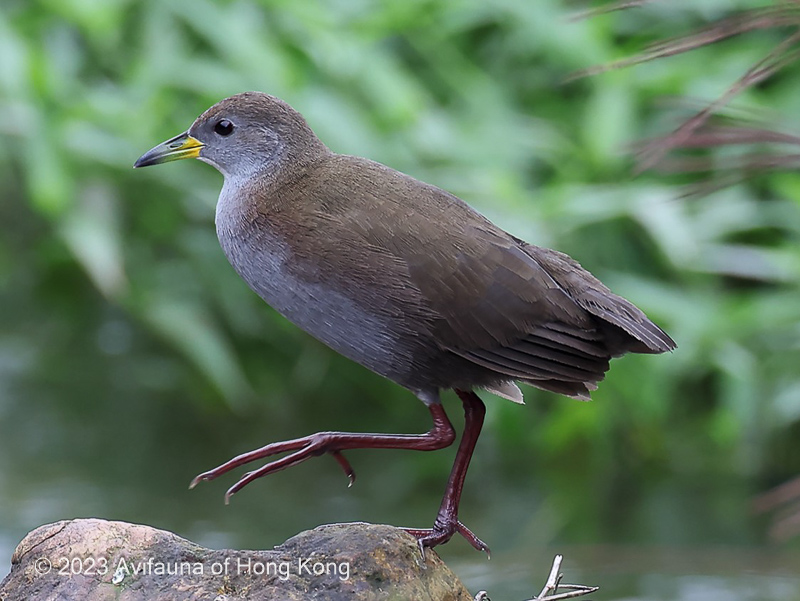Brown Crake Zapornia akool 紅腳苦惡鳥
Category I. Rare and irregular visitor and occasional resident.
IDENTIFICATION

Nov. 2022, Michelle and Peter Wong.
26-28 cm. Plain olive-brown above and olive-grey below with indistinct whitish throat. Deep pinkish-purple legs and yellow/green base to bill; very large feet. Sexes alike, females slightly smaller. Juvenile undescribed.
VOCALISATIONS
The song is a single pure note repeated for some time, unlike that of its regional congeners.
A trilling that resembles Little Grebe but is slightly lower-pitched and often longer is also given (note this recording was made by the nominate subspecies in India).
DISTRIBUTION & HABITAT PREFERENCE
A scattering of records have occurred at a relatively small number of localities, mainly in the central and northeast New Territories and Sai Kung, in lowland areas of stream and dense shrub. Breeding was confirmed in three years during the 1970s and possibly occurred in the 1960s (Kent 1963). Other records have come from Tai Long Wan and Lantau.
OCCURRENCE
Brown Crake is a rare migrant and visitor or occasional long-term resident in HK. Carey et al. (2001) listed 12 records between 1959 and 1997, three of which were multi-year occurrences. One at Tai Wai during 3-4 April 1992 is considered a migrant as it occurred in spring at a small public open space near the railway station. Since then, there have been a further nine records, with the longest stay being 21 days. These included presumed migrants on Po Toi on 16 May 2008, on Chek Lap Kok Airport Island on 29 November 2016 and a distressed bird at Kai Tak Nullah on 19 November 1999. The highest count is three at Tsing Lung Tau on 23 May 1969.
BREEDING
Breeding was confirmed in the 1970s with sightings of two juveniles on 6 June 1971 and 30 April 1972, and another on 22 June 1978. There have been no further episodes of confirmed breeding.
BEHAVIOUR, FORAGING & DIET
Often unobtrusive and retiring, forages at the edge of wetlands and streams, though the birds seen by Kent (1963) fed in the open in a paddy field both when it was fallow after it had been flooded and ploughed.
RANGE & SYSTEMATICS
The nominate subspecies is resident from east Pakistan through much of India to Bangladesh and west Burma; the eastern subspecies Z. a. cocinneipes occurs in northeast Vietnam and southeast China, including HK, with more northerly birds being migratory (Taylor 2020).
CONSERVATION STATUS
IUCN: Least Concern. Population trend unknown.
Kent, S. P. M. (1963). Crimson-legged Crake. Hong Kong Bird Report 1962: 42-43.
Taylor, B. (2020). Brown Crake (Zapornia akool), version 1.0. In Birds of the World (J. del Hoyo, A. Elliott, J. Sargatal, D. A. Christie, and E. de Juana, Editors). Cornell Lab of Ornithology, Ithaca, NY, USA. https://doi.org/10.2173/bow.brocra1.01

